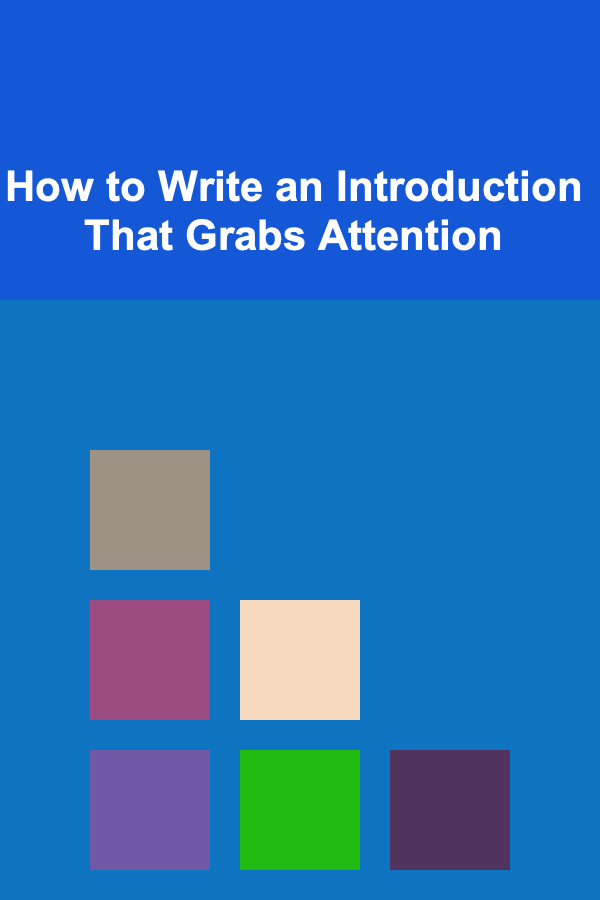
How to Write an Introduction That Grabs Attention
ebook include PDF & Audio bundle (Micro Guide)
$12.99$6.99
Limited Time Offer! Order within the next:

The introduction is the first impression a reader gets of your writing. Whether it's for an essay, a blog post, a research paper, or a novel, the introduction sets the tone for everything that follows. A compelling introduction not only grabs the reader's attention but also piques their curiosity, making them want to read on. A well-crafted introduction can make the difference between someone finishing your piece or abandoning it halfway through. This article delves into the art of writing an introduction that grabs attention, focusing on techniques, psychology, and practical tips to ensure your introduction does what it's supposed to do: captivate and engage your reader from the get-go.
Understanding the Importance of an Introduction
The introduction is like a handshake. It's your chance to make a positive first impression. But just like a weak handshake can make a poor first impression, a lackluster introduction can leave a reader uninterested, no matter how great the content of the rest of your writing may be. Here are a few reasons why your introduction is so important:
1. First Impressions Matter
The human brain forms judgments in fractions of a second. Research suggests that people quickly decide whether to continue reading based on the first few lines of a piece. If those lines are weak or irrelevant, readers may lose interest before they even get to the heart of your argument.
2. Sets the Stage for the Rest of the Piece
The introduction not only grabs attention but also sets the tone for the rest of your writing. It provides the reader with an overview of what to expect and hints at the type of content, style, and tone they can anticipate.
3. Establishes Relevance
In an era where people's attention spans are short, it's essential to immediately establish why your piece matters to your audience. A compelling introduction will not only grab attention but will also tell the reader why they should care.
4. Creates Curiosity
A good introduction makes the reader want to know more. It should leave them curious about the rest of the piece, wondering what the next paragraph holds and how the argument will unfold.
With these points in mind, let's now explore how to write an introduction that can make all the difference between a bored reader and one who is eagerly anticipating what's next.
Techniques for Writing an Attention-Grabbing Introduction
1. Start with a Hook
A hook is a compelling first sentence or phrase that draws the reader in. It could be an interesting fact, a provocative question, a powerful quote, or a vivid description. A well-chosen hook piques curiosity, and it makes the reader want to continue reading to find out more. Here are some examples of different types of hooks:
a. Start with a Provocative Question
A question immediately engages the reader by making them think. A question also invites the reader to stick around for the answer.
- *Example:* "What if everything you thought you knew about success was wrong?"
b. Present a Surprising or Shocking Fact
People are naturally curious, and presenting a surprising fact early in your piece will grab their attention. It will make them wonder why they didn't know this information before and what you'll say next.
- *Example:* "Did you know that over 90% of the world's ocean species remain undiscovered?"
c. Use a Powerful Quote
Quotes from well-known figures can give your writing credibility and add weight to your introduction. Quotes can be inspirational, controversial, or reflective.
- *Example:* "As Albert Einstein once said, 'Imagination is more important than knowledge.'"
d. Create a Vivid Image
Descriptive language helps readers picture a scene, feel emotions, and connect with your writing. You can set the stage for your piece by painting a picture with words.
- *Example:* "The sun was barely visible as it dipped behind the horizon, casting an orange glow over the calm sea."
2. State the Purpose of Your Writing
Once you've hooked the reader, it's important to make it clear what your piece is about. This helps to orient the reader, telling them what to expect. Make sure you succinctly state the purpose or thesis of your writing.
- Example: "In this article, we will explore how digital technologies are reshaping the way we learn, work, and connect with one another."
This statement serves as a roadmap, letting the reader know exactly what problem or question your writing will address and what they will gain from continuing.
3. Make It Personal
One of the most effective ways to engage readers is to make them feel personally connected to the content. Address the reader directly, use inclusive language like "we" or "you," and make them feel like the topic matters to them personally.
- Example: "Have you ever wondered why, despite all your hard work, success still feels elusive? You're not alone."
This establishes a connection between you and the reader, and it shows that you understand their struggles. It also creates a sense of intimacy, making the reader more likely to continue reading.
4. Provide Background Information or Context
Sometimes, before diving into the main points, it's helpful to provide the reader with some context. This can be especially important when dealing with complex or unfamiliar topics. The introduction should establish why the topic is important and why it matters now.
- Example: "In a world where climate change threatens to disrupt ecosystems and economies, it's more crucial than ever that we understand the science behind it."
By providing some context, you help the reader understand why the topic at hand is significant and why it's worth their time and attention.
5. Create a Sense of Urgency
A sense of urgency in the introduction makes the reader feel like they must continue reading now, rather than later. Whether it's a pressing issue, a limited opportunity, or an emerging trend, highlighting urgency makes the topic feel more immediate and important.
- Example: "Time is running out. If we don't take action now, the irreversible effects of global warming will become more severe."
Urgency drives action. If you can convey to the reader that they need to keep reading to avoid missing out on something important, they're more likely to stick around.
6. Establish a Tone and Voice
The tone of your introduction sets the mood for the entire piece. It tells the reader how to feel about the subject matter. Whether it's lighthearted, serious, sarcastic, or academic, the tone of the introduction should align with the purpose of your writing.
- Example (Serious): "The financial crisis of 2008 has reshaped the global economy in ways we are still grappling with today."
- Example (Lighthearted): "Let's face it, we all love a good underdog story. But what makes some people rise from the depths of failure while others remain stuck?"
The tone should match the topic, your audience, and your overall message. If your piece is a humorous blog post, a funny or witty introduction will set the right tone. If it's a serious academic paper, you'll want to adopt a more formal tone.
7. Incorporate a Story or Anecdote
Humans are hardwired to respond to stories. Starting with a brief anecdote or a personal story can hook the reader by engaging their emotions. The story should be relevant to your main topic and set up the argument or points you will cover.
- Example: "When I first tried my hand at entrepreneurship, I faced a mountain of failures. But it was these failures that ultimately taught me the lessons I needed to succeed."
A story or anecdote allows the reader to see the human side of your argument. It also creates a narrative structure that makes the introduction feel less like an abstract argument and more like a conversation.
Common Pitfalls to Avoid
While there are several ways to grab your reader's attention, there are also common pitfalls that can undermine your introduction's effectiveness. Here are a few to keep in mind:
1. Overloading the Introduction with Information
While context is important, giving away too much in the introduction can spoil the content of the rest of the piece. Avoid dumping too many facts or overwhelming the reader with information. Stick to a few key points to whet the reader's appetite.
2. Being Too Vague
If your introduction is too vague or unclear about the purpose of your writing, the reader may lose interest. Be specific about what the reader will gain by continuing and what the piece will cover.
3. Using Clichés
Avoid overused phrases or trite expressions that can make your writing sound formulaic or uninspired. Phrases like "In today's world," "For many years," or "Ever since the dawn of time" are common but unoriginal. Aim to stand out with fresh language.
4. Starting with a Weak Generalization
Starting with broad generalizations can make your introduction seem superficial. Phrases like "Since the beginning of time" or "Everyone knows" are vague and don't offer much value. Instead, make your opening specific and grounded in reality.
Conclusion
A great introduction is essential for drawing readers in and keeping them engaged. By using a combination of a strong hook, clear purpose, personal connection, and relevant context, you can craft an introduction that grabs attention and encourages readers to keep going. Avoid common pitfalls like overloading the reader with information or using clichés. With practice, you'll be able to master the art of writing introductions that not only captivate your audience but also set the stage for a successful and impactful piece.

How to Embrace Budget Boho Decor for a Relaxed Vibe
Read More
How to Make a Checklist for Building a Professional Online Profile
Read More
How to Soundproof Your Walls Using Soundproofing Insulation
Read More
How to Upgrade Your Home's Lighting for a More Modern Look
Read More
How to Use VR for Art and Creative Expression
Read More
Restoring Degraded Wildlife Habitats: A Comprehensive Guide
Read MoreOther Products

How to Embrace Budget Boho Decor for a Relaxed Vibe
Read More
How to Make a Checklist for Building a Professional Online Profile
Read More
How to Soundproof Your Walls Using Soundproofing Insulation
Read More
How to Upgrade Your Home's Lighting for a More Modern Look
Read More
How to Use VR for Art and Creative Expression
Read More